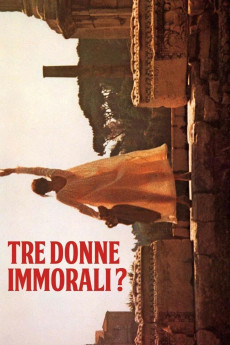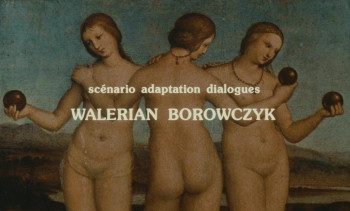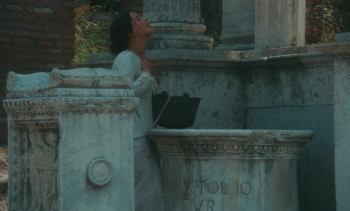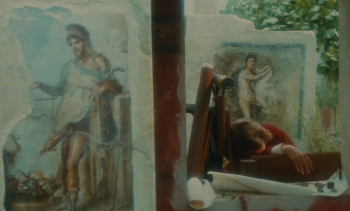Plot summary
The first episode – featuring frequent Borowczyk muse Marina Pierro – is the longest and, in a way, most substantial: it’s set in Renaissance Rome, with the lusty (and perpetually nude) leading lady sexually involved with famous painters and church benefactors. The second episode is the most notorious and, consequently, gave the film its controversial poster – featuring a rabbit slowly disappearing under the skirt of a teenage girl (played by Gaelle Legrand). The third and final episode, which has a modern-day setting, is the shortest – but also, possibly, the most outrageous: Pascale Christophe is a young married woman who’s abducted on a busy Parisian street by a small-time hood hidden inside a cardboard box!
Director
Top cast
Tech specs
720p.BLU 1080p.BLUMovie Reviews
Another sick movie maker!
IMMORAL WOMEN (Walerian Borowczyk, 1979) **1/2
This is another Borowczyk compendium of erotica: the original title may translate to HEROINES OF EVIL, but the film might just as well be considered a sequel to his IMMORAL TALES (1974) – hence the similar moniker.
The first episode – featuring frequent Borowczyk muse Marina Pierro – is the longest and, in a way, most substantial: it’s set in Renaissance Rome, with the lusty (and perpetually nude) leading lady sexually involved with famous painters and church benefactors. However, the girl is revealed to be harboring motives of her own, as she proceeds to poison and rob her wealthy admirers for the sake of her true love! Worth noting here – apart, obviously, from the luscious Pierro’s classical beauty – is the period décor, especially the labyrinth in which Raffaello’s quarters are concealed.
The second episode is the most notorious and, consequently, gave the film its controversial poster – featuring a rabbit slowly disappearing under the skirt of a teenage girl (played by Gaelle Legrand). This segment is also a period piece, but it’s set in 19th century France – with the girl’s excessive fondness for her pet bunny (she likes to spread on the garden lawn stark naked and let the curious, furry little animal ‘explore’ her body!) falling foul of her condescending and slightly barmy family. She then visits the horny black butcher who supplies them with lamb chops (ostensibly to steal his carving knife) but he proceeds to ravage her, immediately regrets his selfish act and decides to hang himself – leaving the girl free to exact her bloody revenge on her oblivious sleeping parents. The latter event, then, subsequently becomes a bedtime story told by Legrand to her companions at the orphanage she ends up in!
The third and final episode, which has a modern-day setting, is the shortest – but also, possibly, the most outrageous: Pascale Christophe is a young married woman who’s abducted on a busy Parisian street by a small-time hood hidden inside a cardboard box! They move inconspicuously (i.e. the box moves!) through the crowd until they reach his van, from where he starts organizing her ransom. She goes to a phone booth to call her husband, all the while being in the criminal’s line of fire; the woman’s faithful Doberman senses that something is wrong and sets out in pursuit of her. Amazingly, the dog manages to locate the van by a river and savagely attacks the young man (who, at the time, was raping its mistress) as soon as he appears out of the vehicle…but the same thing happens when the husband finally arrives (both he and the criminal, screaming in pain, eventually tumble into the water). Apparently, the woman is unperturbed by all of this – and is merely overjoyed at her savior’s prowess!
IMMORAL WOMEN, therefore, provides many of Borowczyk’s typical ingredients – filmed in his traditional dreamy soft-focus and set to the equally familiar strains of a harpsichord/synthesizer-based score: sexualized objects, suggestions of bestiality, a depraved religious environment (which includes depicting Michelangelo as a neurotic homosexual given to liberating bouts of mud-slinging!), snooty bourgeoisie, etc. As was the case with IMMORAL TALES, the cumulative experience of the film is somewhat underwhelming and, at nearly 2 hours, decidedly draggy; such slight and fanciful pieces are, perhaps, best sampled individually! Even if Borowczyk started his career by churning out surrealist animated shorts, it seems to me that he did his most potent work when his themes were fleshed out to feature-length form (a case in point being THE BEAST [1975], whose bizarre centre-piece was initially intended to form part of IMMORAL TALES itself – but was ultimately given added texture by being framed inside a modern, and quite fascinating, morality play!).











